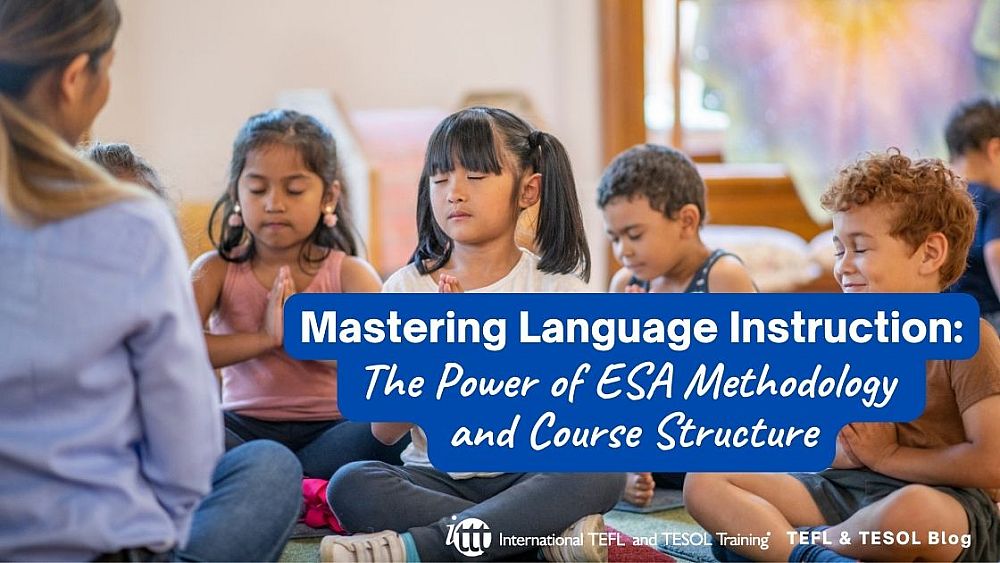Mastering Language Instruction: The Power of ESA Methodology and Course Structure

Teaching is a dynamic process that requires careful planning and effective methodologies to engage students and promote their learning. One widely used approach is the ESA (Engage, Study, Activate) methodology. This summative task explores the importance of a well-structured teaching course and highlights the key elements of the ESA methodology as a valuable framework for successful language instruction.
Table of Contents
Importance of a Well-Structured Teaching Course
The ESA Methodology: Providing Structure
Advantages of the ESA Methodology
Conclusion: The Value of Structure and ESA Methodology
Are you ready to teach English as a foreign language?
Check out what our course grads say in our many video testimonials!
Disclaimer: The views and opinions expressed in this blog post are solely those of the author, an alumni of ITTT (International TEFL and TESOL Training). They do not necessarily reflect the views or opinions of ITTT. The content provided in this post is for informational purposes only and should not be considered as official endorsement or representation by ITTT.
Importance of a Well-Structured Teaching Course
Firstly, we will explore the importance of a well-structured teaching course. Having an established and clear objective outlines what students should be able to achieve by the end of the course. This provides a roadmap for both teachers and students, ensuring that the learning outcomes are aligned with the curriculum and providing grounds for effective assessment of learning. We also benefit from a planned progression of lessons. This ensures a flow of concepts and skills learned, allowing students to build upon previous knowledge. This also helps when introducing new topics and reviewing previous lessons, and allows the teacher to gauge the student's comprehension and retention. It is also important to provide a variety of learning activities, such as discussions, group work, presentations, and hands-on tasks, which are necessary to accommodate different learning styles and increase students' engagement with the lesson. Activities should center around activating students' creativity, critical thinking, encouraging active participation, and creating a positive learning environment.
The ESA Methodology: Providing Structure
The Engage, Study, Activate (ESA) methodology helps provide the structure a teaching course needs. The Engage phase focuses on capturing the students' attention and generating interest in the lesson, creating a positive learning atmosphere through students' curiosity and motivation. These activities include thought-provoking questions, real-world examples, multimedia resources, or interactive tasks that encourage students to share their thoughts and experiences related to the topic. The Study component of ESA lessons presents new information, introduces language concepts, and provides opportunities for guided practice. The goal is to have students deepen their understanding and acquire new knowledge and skills. This phase often includes explanations, demonstrations, reading materials, audiovisual resources, and exercises that promote comprehension and consolidate learning. Finally, the Activate section incorporates all new knowledge into practical use in meaningful contexts. Students are encouraged to use language spontaneously, promoting fluency, confidence, and communication. Activities often involve role-plays, discussions, debates, problem-solving tasks, and creative projects that require students to actively engage in using the language to express their ideas and opinions.
Advantages of the ESA Methodology
The ESA methodology has shown itself to have many advantages for providing structure to lessons. It prioritizes student engagement through interactive and student-centered activities. By involving students actively in the learning process, it enhances their motivation and promotes a positive attitude towards learning. The methodology integrates the four language skills—listening, speaking, reading, and writing—promoting a balanced development of language proficiency. By providing ample opportunities for practice and application, the ESA methodology facilitates language acquisition and helps students retain what they have learned. The Activate phase also demonstrates its benefits through encouraging students to use the language authentically in real-world contexts. This enables them to develop their communicative competence and prepares them for practical language use outside the classroom.
Conclusion: The Value of Structure and ESA Methodology
A well-structured teaching course is essential for effective instruction, enabling teachers to achieve learning objectives and engage students in meaningful ways. The ESA methodology, with its Engage, Study, and Activate phases, provides a valuable framework for planning and delivering lessons that promote student engagement, language acquisition, and application of language skills.
Are you ready to teach English as a foreign language?
Apply now & get certified to teach english abroad!
Speak with an ITTT advisor today to put together your personal plan for teaching English abroad!
Send us an email or call us toll-free at 1-800-490-0531 to speak with an ITTT advisor today.
Related Articles:
- Top 10 Cities in Europe with the Highest Demand for English Language Teachers
- 5 Reasons To Take A TEFL Course Right Now - Even If You Are Not Leaving Yet | ITTT | TEFL Blog
- All the Documents You Will Need to Teach English Abroad
- The Impact of Positive Motivation on an ESL Classroom
- You're Never Too Old to Change Your Life and Do a TEFL Course | ITTT | TEFL Blog
- Getting Student Placement Right - The Best Desk Arrangements for EFL Students



